Karen Sanders - My Family from Stavisht - JewishGen KehilaLinks
Karen Sanders - My Family from Stavisht - JewishGen KehilaLinks
Karen Sanders - My Family from Stavisht - JewishGen KehilaLinks
Create successful ePaper yourself
Turn your PDF publications into a flip-book with our unique Google optimized e-Paper software.
<strong>My</strong> <strong>Family</strong> <strong>from</strong> <strong>Stavisht</strong><br />
Written and submitted by <strong>Karen</strong> Isabel <strong>Sanders</strong><br />
<strong>My</strong> paternal grandparents, Tazi and Beile, were born in<br />
<strong>Stavisht</strong>, Ukraine and were married there in 1908. They were<br />
quiet, kind, and loving people. They had little money, but were<br />
rich in spirit and family pride. When they were alive, I never<br />
knew that they had Americanized given names; I never heard<br />
anyone refer to them as anything but Tazi and Beile <strong>Sanders</strong>. So<br />
I was quite surprised to find out that their American names were<br />
Isadore and Becky. Their Americanized surname came <strong>from</strong><br />
some variation of Sanderovitch, Sandrowicz, Sanderovi, or<br />
Sandrowitz. The reason for the uncertainty is that my<br />
grandparents gave their surname in many different forms on many different documents. I use the<br />
surname Sanderovitch, as that is the name that sticks out in my memory <strong>from</strong> childhood. The<br />
name Tazi is a mystery to everyone. His given name, <strong>from</strong> his ship manifest, was Eisig. Yitzhak<br />
Aizik is the Hebrew name on his tombstone. Everyone in the family was told that my<br />
grandmother’s maiden name was Levine, but all documents show that her family name was<br />
Lewit. Go figure!<br />
<strong>My</strong> grandparents never spoke about their life in <strong>Stavisht</strong>, the reason for leaving, or the<br />
family they left behind. They had died before I was old enough to start asking questions about<br />
such things. Thankfully, there were others in the family who were not as reticent about the<br />
Sanderovitch and Lewit family life in <strong>Stavisht</strong>.<br />
When my grandma was still a little girl, my grandfather had fallen in love with her. Tazi<br />
told his father that Beile Lewit was the girl he was going to marry. His father, Tevya Leyb,<br />
laughed at his son and told him to wait and see what would happen. On May 15, 1908, Tazi<br />
married Beile. Tazi was 25, and Beile was only 17. I know that the love my grandfather had for<br />
his bride lasted even after her untimely death in 1954.<br />
In May 1910, Beile gave birth to their first son, Nisol. He was named after Beile’s father,<br />
Nison Leyb Lewit. Tazi wanted money to enlarge and improve their home in <strong>Stavisht</strong> for his<br />
growing family. So he decided to go to America to earn the money faster than he could in<br />
<strong>Stavisht</strong>. Beile was pregnant with their second child when Tazi boarded the boat to America in<br />
February 1913. In May 1913, Beile gave birth to their second son, Smil.<br />
When my grandfather arrived in America, he lived with a landsman, Israel Menis. Israel<br />
taught my grandfather the fruit and vegetable business. Tazi started out selling potatoes on street<br />
corners in Manhattan. Slowly, he was able to save enough to buy a larger cart, and to increase<br />
his stock. He lived frugally and was able to start sending money to my grandmother. Within a<br />
few years, Tazi had sent enough money to Beile to improve their home and install wood floors.<br />
Tazi could not return to <strong>Stavisht</strong>, because World War I had started. He worried about his family<br />
1
and continued to work his growing business. He was informed by Beile that part of their home<br />
had been destroyed by a gang raid. Tazi would have to earn more money to repair it.<br />
News of the Russian revolution reached America, along with letters <strong>from</strong> <strong>Stavisht</strong> that<br />
told of the raids and thugs that were attacking villages. Tazi did not send for his family, as he<br />
hoped that things would settle down and his family could live in peace in their little shtetl. He<br />
did send them money to flee the area until the political situation and violence subsided. Before<br />
Beile could leave the shtetl, the pogroms had taken the lives of her mother and Tazi’s parents.<br />
Beile’s sisters, Sheve and Feige Lewit, were also<br />
<strong>from</strong> <strong>Stavisht</strong>. <strong>My</strong> great aunts, Sheve and Feige, lived with<br />
their widowed mother, Kayla (nee Shpritzanietski), in a<br />
small, one-room house with dirt floors. They lived on<br />
Shuglasse Street (Synagogue Street). They made and sold<br />
cheese and eggs for their meager living. The street was<br />
always muddy, and my aunts had to wear boots all the time.<br />
One day, when they heard that a gang was coming to<br />
<strong>Stavisht</strong>, Kayla told her daughters to run into the woods and<br />
hide. When the daughters returned, they found their mother<br />
had been beaten badly by the gang. Kayla died <strong>from</strong> her<br />
injuries. Shortly thereafter, their brother, Itzar, told his<br />
sisters that they all had to leave <strong>Stavisht</strong> or they would be killed.<br />
2<br />
Sheve & Feige Lewit w/my father, 1927.<br />
Beile, her two young sons, and her two sisters packed up what they could carry and left<br />
<strong>Stavisht</strong>. I know that Beile had every intention of returning, because she wrapped and buried her<br />
Shabbat candlesticks and other valuables in the backyard of her house. The three sisters and two<br />
young boys headed toward Bessarabia. They walked at night, hiding in ditches during the day to<br />
evade the soldiers and gangs. It was a difficult and dangerous journey. <strong>My</strong> grandfather realized<br />
that their little shtetl was destroyed and that they could never return. He sent my grandmother<br />
money to come to America. She arrived in New York in February 1921. Sheve arrived a month<br />
later, followed in May by Feige. Itzar and his family fled to parts unknown to me. He did not<br />
come to America. He eventually died at Babi Yar.<br />
Tazi worked hard in the U.S. as a fruit and vegetable vendor, selling his wares <strong>from</strong> a<br />
horse and wagon. His third son, my father, Theodore Leon (named for his murdered<br />
grandfather) was born in July 1922. His fourth son, Kalman (named for his murdered<br />
grandmother Kayla) was born in November 1927.<br />
Tazi moved his family to Washington Avenue in the Bronx. He opened a small fruit<br />
store on Bathgate Avenue. This area was very similar to a shtetl in the old country. There were<br />
all sorts of little stalls selling all sorts of goods. All of the stores had their stalls outside the store.<br />
There were no cash registers; the vendors wrote the prices of customers’ merchandise on the<br />
brown paper bags and added them up in their heads. Everyone bargained for prices and<br />
complained about the quality of the goods (no doubt to get a better price). There were no<br />
supermarkets and no large general stores in that area. Instead of one large temple, there were<br />
many, many little shuls and houses of prayer. It seemed to me that everyone spoke Yiddish and
held a Yiddish language newspaper in their hands. I always felt that I was in a foreign country<br />
when I went to visit my grandparents. Foreign, but nice and inviting.<br />
Fond Memories<br />
I remember my grandma Beile holding me in her arms and letting me drop the cheese<br />
knaidlach in a big pot of boiling water. She wore a fatsheyla (a kerchief so no hair would get<br />
into the food), and put one on my head as well. I remember my grandpa Tazi putting a sugar<br />
cube in his mouth while drinking tea <strong>from</strong> a glass. I remember drinking cherry-flavored seltzer<br />
water <strong>from</strong> an old Yizkor candle glass. I remember the bowl of borsht with a boiled potato<br />
sitting in its center. I remember the chicken soup, pickles, pickled green tomatoes, and cabbage<br />
that were always on the table. I remember going to a little shul with my grandfather and feeling<br />
so proud when he marched around carrying the Torah. He was proud, too, watching his little<br />
granddaughter sitting in the women’s section, happy to be in temple with her grandfather. I was<br />
always aware that my grandparents had little money, but much spirit and love for each other and<br />
their family.<br />
Epilogue<br />
In 1928, my aunt Sheve got married to Solomon Woron (Schloime<br />
Voronofski), who was <strong>from</strong> Cherkas. She seems to be the only member of<br />
the family that passed along many of the details of life in <strong>Stavisht</strong>. She and<br />
Sol had two children.<br />
<strong>My</strong> aunt Feige was still not married by 1949. So, following the<br />
tradition of shtetl culture, the women of the family gathered to discuss the<br />
situation. We had many relatives <strong>from</strong> Boyarka, the very little shtetl 21<br />
miles <strong>from</strong> <strong>Stavisht</strong>. A cousin, Ida Goldberg (nee Chaika Sokol), said that<br />
her husband’s cousin was in need of a wife. Moishe Goldberg was a<br />
widower with three young children and was living in New Haven,<br />
Connecticut. The women decided that it would be a good match, and Feige<br />
agreed. Feige married Moishe Goldberg of Boyarka in 1949.<br />
<strong>My</strong> uncle Nat (Nisol) grew up in the Bronx<br />
and served in the Army in World War II. He<br />
married and had one daughter. He, too, went into<br />
the produce business. <strong>My</strong> uncle Sammy (Smil)<br />
served in the Army in World War II. He married<br />
and had two sons. He worked in the produce field<br />
as well. Theodore Leon served in the Marines in<br />
World War II. He married after the war and had<br />
three daughters. Kalman served in the Navy<br />
during World War II. He married and had two<br />
sons.<br />
The <strong>Sanders</strong> <strong>Family</strong>, 1951.<br />
L to R; Nathan (Nisol), Theodore, Beile,<br />
Sam (Smil), Tazi and Kalman.<br />
3




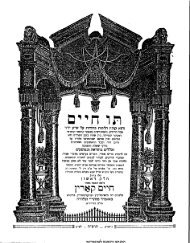


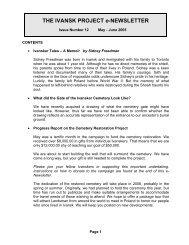
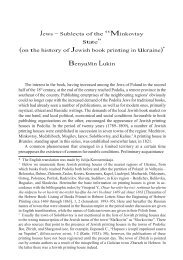
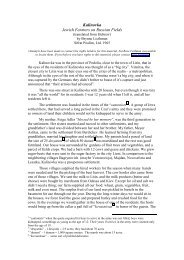
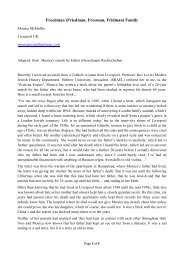
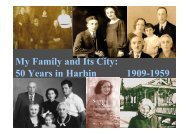



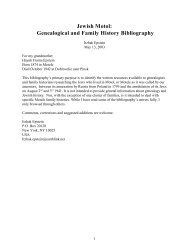
![Carta de Jaime Cesar [Negro] Lipovetzky - JewishGen KehilaLinks](https://img.yumpu.com/19183893/1/190x245/carta-de-jaime-cesar-negro-lipovetzky-jewishgen-kehilalinks.jpg?quality=85)